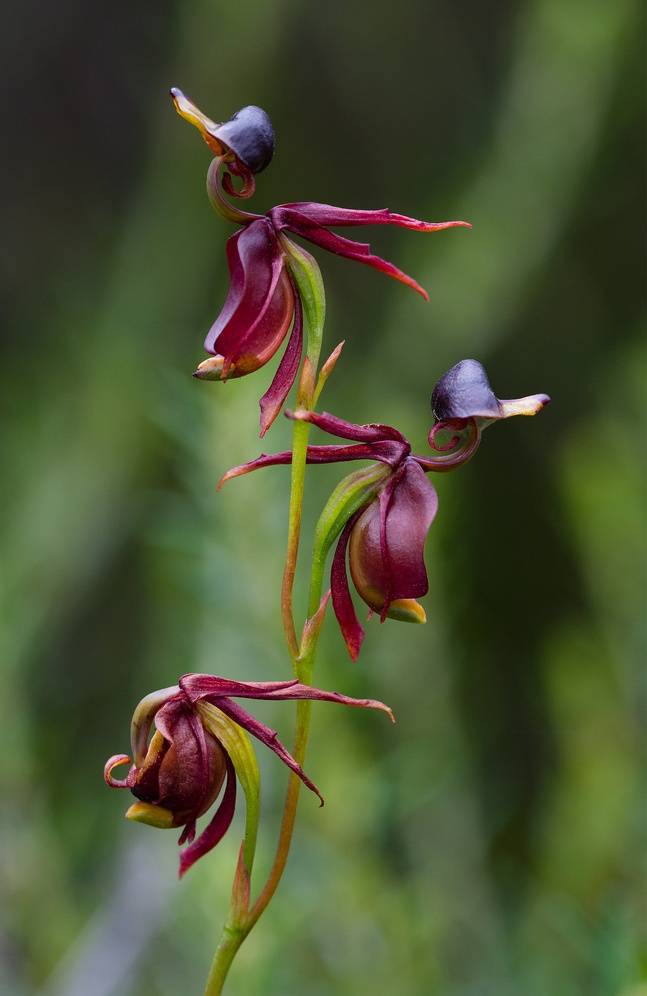12 March 2022
The Flying Duck Orchid - Australia's Other Amazing Anatine Attraction
The Caleana is more often known as the Duck Orchid – and for fairly obvious reasons. It looks like a duck in flight, its wings swept back, head and beak held high and proud. This attractive yet amusing addition to the orchid genus is a native of Australia, famed perhaps more for its marsupials than its mallards (platypodes aside). Yet as a result of the shape of its labellum (or lip) its anatine association will be that by which it is always remembered.
The labellum which gives the duck orchid its distinct characteristics is a vital part of its strategy to propagate the species. Botanically speaking, the labellum is the part of the flower which has developed to attract the insects which, it is hoped, will pollinate the flower. Furthermore, its length and breadth serves as a landing pad for the insect – in the case of the duck orchid that insect is the sawfly.
The two other petals of caleana look more like sepals and stretch back, almost like the wings of a duck in flight. This makes the labellum appear larger to insects than it actually is and increases its chances of attracting a sawfly to its pollen. It has another trick up its metaphorical sleeve, too.
If a sawfly lands on the column of the flower its weight forces the labellum to spring down on to it. The insect is trapped and the only way it can get out is a route which takes it via the pollen. Once the sawfly makes its exit (no doubt somewhat confused and bewildered) the labellum is gradually restored to its original position, awaiting the next sawfly to come along.
The duck orchid is a perennial but blooms in late spring or early summer. At up to 45 centimeters in height you might think it would stand out in its natural habitat. However, because of the reddy-brown colors of both the stem and flowers it moulds in to its Australian environs so expertly that it becomes almost invisible – unless you are deliberately seeking out its company.
If you have suddenly been gripped by the desire to own your very own duck orchid then you will be disappointed. Despite numerous attempts, this orchid stubbornly refuses to be propagated, and is only found in the wild. This is because the roots of caleana have a symbiotic relationship with the vegetative part of a fungus which only thrives in the part of Australia in which it originates. The fungus helps the plant to stave off infections and without its help the duck orchid never lasts long.
Fortunately for the duck orchid, it is found in hundreds of locations in the south west of Australia. If, however, you want to see this remarkable orchid for yourself, you will have to visit its country of origin and call on it at home. There are, after all, many worse ways to spend your vacation. You might even see the other example of Australia's amazing anatine attractions too - the duck billed platypus.
First Image Credit Flickr User Boobook48
The labellum which gives the duck orchid its distinct characteristics is a vital part of its strategy to propagate the species. Botanically speaking, the labellum is the part of the flower which has developed to attract the insects which, it is hoped, will pollinate the flower. Furthermore, its length and breadth serves as a landing pad for the insect – in the case of the duck orchid that insect is the sawfly.
The two other petals of caleana look more like sepals and stretch back, almost like the wings of a duck in flight. This makes the labellum appear larger to insects than it actually is and increases its chances of attracting a sawfly to its pollen. It has another trick up its metaphorical sleeve, too.
If a sawfly lands on the column of the flower its weight forces the labellum to spring down on to it. The insect is trapped and the only way it can get out is a route which takes it via the pollen. Once the sawfly makes its exit (no doubt somewhat confused and bewildered) the labellum is gradually restored to its original position, awaiting the next sawfly to come along.
The duck orchid is a perennial but blooms in late spring or early summer. At up to 45 centimeters in height you might think it would stand out in its natural habitat. However, because of the reddy-brown colors of both the stem and flowers it moulds in to its Australian environs so expertly that it becomes almost invisible – unless you are deliberately seeking out its company.
If you have suddenly been gripped by the desire to own your very own duck orchid then you will be disappointed. Despite numerous attempts, this orchid stubbornly refuses to be propagated, and is only found in the wild. This is because the roots of caleana have a symbiotic relationship with the vegetative part of a fungus which only thrives in the part of Australia in which it originates. The fungus helps the plant to stave off infections and without its help the duck orchid never lasts long.
Fortunately for the duck orchid, it is found in hundreds of locations in the south west of Australia. If, however, you want to see this remarkable orchid for yourself, you will have to visit its country of origin and call on it at home. There are, after all, many worse ways to spend your vacation. You might even see the other example of Australia's amazing anatine attractions too - the duck billed platypus.
First Image Credit Flickr User Boobook48



















